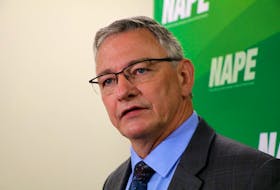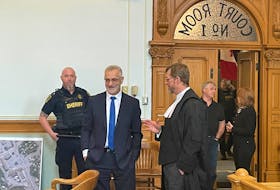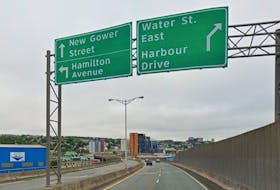ST. JOHN'S, N.L. — At the Muskrat Falls Inquiry on Monday, two witnesses provided new details on SNC-Lavalin’s early project estimate, spoke about the change of SNC-Lavalin’s role from an engineering, procurement and construction management (EPCM) contractor, and addressed the now-infamous 2013 risk report.
Both men appeared by Skype rather than in person. One testified from Montreal, the other from Calgary. According to response from inquiry staff, the teleconferencing was both for the convenience of the witnesses and to save the inquiry the cost of flying them to and from St. John’s, as they were both scheduled for only a half-day appearance.
Jean-Daniel Tremblay, appearing from Montreal, described helping build the “basis of estimate” for the capital cost.
The SNC-Lavalin team didn’t handle the subsea Strait of Belle Isle crossing, or review the costs associated with permitting or owner-specific costs, but ran the numbers on most of the project, submitting an estimate in December 2011.
There was “fine-tuning” with updated information in early 2012. Nalcor also made some unilateral edits, and added in its other costs, to reach the $6.2-billion price the project was sanctioned on at the end of 2012.
Tremblay (who reported to Paul LeMay, to appear Friday by Skype) said everything put into the estimate was validated by more senior managers and colleagues with SNC-Lavalin who specialized in relevant areas – costing high-power transmission, substations and heavy civil work.
There were about 40 binders of supporting documents, and SNC-Lavalin’s work was reviewed by the American Association of Cost Engineers, Tremblay said.
“I don’t agree with the ‘poor quality’ aspect. … I didn’t agree with the notion it was poor quality,” he said of the estimate, responding to criticisms coming since the project ran billions of dollars over budget.
Tremblay’s description of the SNC-Lavalin team’s depth of experience in hydroelectric projects was contrasted against the Nalcor Energy management team, with experience mainly in oil and gas.
“These are two different industries completely,” Tremblay said, describing differences in terminology, technical approaches and approach to project uncertainties.
It led to clashes, he testified.
“We usually had two different lenses on how to go forward,” Tremblay said.
He described the change in SNC-Lavalin’s contract in 2012 as a “Nalcor takeover” where SNC’s team was “kind of pushed aside.”
He described working for a time as a risk co-ordinator. He left the project in response to a Nalcor request for new blood in 2013, something he believes was related to his work on an internal risk report, and his suggestion risk management was slipping in the list of Nalcor priorities.
“Did they have world-class experience in large hydro? No,” said Scott Thon, who appeared by teleconference from Calgary.
Thon said he would have liked Nalcor’s project management team to sustain leadership roles for SNC’s people, or individuals with more hydro experience.
Thon was called on to run SNC-Lavalin’s global power division in 2013, amid internal shuffling in the midst of legal woes. His role was at the executive level, dealing with the unhappy client on the Muskrat Falls project.
He was asked by Nalcor lawyer Dan Simmons about a list of problems Nalcor’s management team had noted in relation to SNC-Lavalin’s performance, pre-dating Thon’s time on the project.
“I wouldn’t say it’s as dire as what these words say,” he said, reviewing the list, referring to one of the points, before suggesting counter arguments to other items.
By the fall of 2013, negotiations had started on the new Nalcor-SNC contract.
Thon spoke about the private review of risk, completed before the project’s financial close in 2013. It was first suggested inside SNC-Lavalin, he said, because of the company’s changing role. The thought was there was a closing door for some project information. It was considered a “cold-eyes review” and the report was an internal SNC document, Thon said.
He said not all of the risks identified were discussed at the executive level – supporting comments made on the same by former Nalcor Energy president and CEO Ed Martin. Thon also said key risks were discussed in detail, and he believed others were being dealt with “at the project level” by middle managers.
Thon said Nalcor’s project team became reticent and regular steering committee meetings he took part in, with senior executives, were “not as effective as they could be.”
At the end of February 2014, when Thon left work on the project, the relationship between SNC-Lavalin and Nalcor Energy was still unclear, he said.
Eager to recover a slipping schedule for the inquiry, Commissioner Richard LeBlanc insisted on sitting late on Monday, with Thon on the stand until roughly 7 p.m. NT. LeBlanc is getting another early start on Tuesday, beginning at 9 a.m. NT.
TWITTER: @TeleFitz
RELATED









